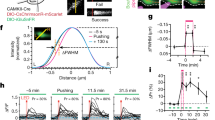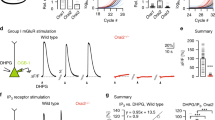Abstract
The importance of second-messenger systems in controlling the excitability of neurones and other cells, through modulation of voltage- and calcium-dependent ionic conductances, has become increasingly clear. Cyclic AMP1–3, acting via protein kinase A4–6, has been identified as the second messenger for several neurotran-smitters, and recent studies have suggested that activation of protein kinase C may have similar modulatory actions on neurones7–11. Calcium and potassium currents have so far been shown to be the major ionic conductances modified by kinase activation4–11. We now report that hippocampal pyramidal cells contain a previously undescribed voltage-dependent chloride current which is active at resting potential and is turned off either by membrane depolarization or by activation of protein kinase C by phorbol esters. We propose that this current may reside predominantly in the cell's dendritic membrane and thereby may regulate dendritic excitability.
This is a preview of subscription content, access via your institution
Access options
Subscribe to this journal
Receive 51 print issues and online access
$199.00 per year
only $3.90 per issue
Buy this article
- Purchase on Springer Link
- Instant access to full article PDF
Prices may be subject to local taxes which are calculated during checkout
Similar content being viewed by others
References
Cachelin, A. B., dePeyer, J. E., Kokubun, S. & Reuter, H. Nature 304, 462–464 (1983).
Madison, D. V. & Nicoll, R. A. J. Physiol., Land. 372, 245–259 (1986).
Siegelbaum, S. A., Camardo, J. S. & Kandel, E. R. Nature 299, 413–417 (1982).
Ewald, D. A., Williams, A. & Levitan, I. B. Nature 315, 503–506 (1985).
Osterrider, W. et al. Nature 298, 576–578 (1982).
Shuster, M. J., Camardo, J. S., Siegelbaum, S. A. & Kandel, E. R. Nature 313, 392–395 (1985).
Baraban, J. M., Snyder, S. H. & Alger, B. E. Proc. natn. Acad. Sci. U.S.A. 82, 2538–2542 (1985).
Malenka, R. C., Madison, D. V., Andrade, R. & Nicoll, R. A. J. Neurosci. 6, 475–480 (1986).
DeReimer, S. A., Strong, J. A., Albert, K. A., Greengard, P. & Kaczmarek, L. K. Nature 313, 313–316 (1985).
Rane, S. G. & Dunlap, K. Proc. natn. Acad. Sci. U.S.A. 83, 184–188 (1986).
Strong, J. A., Fox, A. P., Tsien, R. W. & Kaczmarek, L. K. Biophys. J. 49, 430a (1986).
Halliwell, J. V. & Adams, P. R. Brain Res. 250, 71–92 (1982).
Collingridge, G. L., Gage, P. W. & Robertson, B. J. Physiol., Lond. 356, 551–564 (1984).
White, M. W. & Miller, C. J. biol Chem. 254, 10161–10166 (1979).
Chesnoy-Marchais, D. Nature 299, 357–361 (1982).
Chesnoy-Marchais, D. J. Physiol., Lond. 342, 277–308 (1983).
Selyanko, A. A. J. Physiol., Lond. 350, 49P (1984).
Castagna, M. et al. J. biol. Chem. 257, 7847–7851 (1982).
Madison, D. V. & Nicoll, R. A. J. Physiol., Lond. 372, 221–244 (1986).
Author information
Authors and Affiliations
Rights and permissions
About this article
Cite this article
Madison, D., Malenka, R. & Nicoll, R. Phorbol esters block a voltage-sensitive chloride current in hippocampal pyramidal cells. Nature 321, 695–697 (1986). https://doi.org/10.1038/321695a0
Received:
Accepted:
Issue Date:
DOI: https://doi.org/10.1038/321695a0
This article is cited by
-
Regulation of fast-spiking basket cell synapses by the chloride channel ClC-2
Nature Neuroscience (2010)
-
Protein-protein interactions in the yeastPKC1 pathway: Pkc1p interacts with a component of the MAP kinase cascade
Molecular and General Genetics MGG (1996)
-
Aging and chloride channel regulation in rat fast-twitch muscle fibres
Pflügers Archiv (1994)
-
Autophosphorylation: a salient feature of protein kinases
Molecular and Cellular Biochemistry (1993)
-
The role of excitatory amino acid receptors and intracellular messengers in persistent nociception after tissue injury in rats
Molecular Neurobiology (1993)
Comments
By submitting a comment you agree to abide by our Terms and Community Guidelines. If you find something abusive or that does not comply with our terms or guidelines please flag it as inappropriate.



